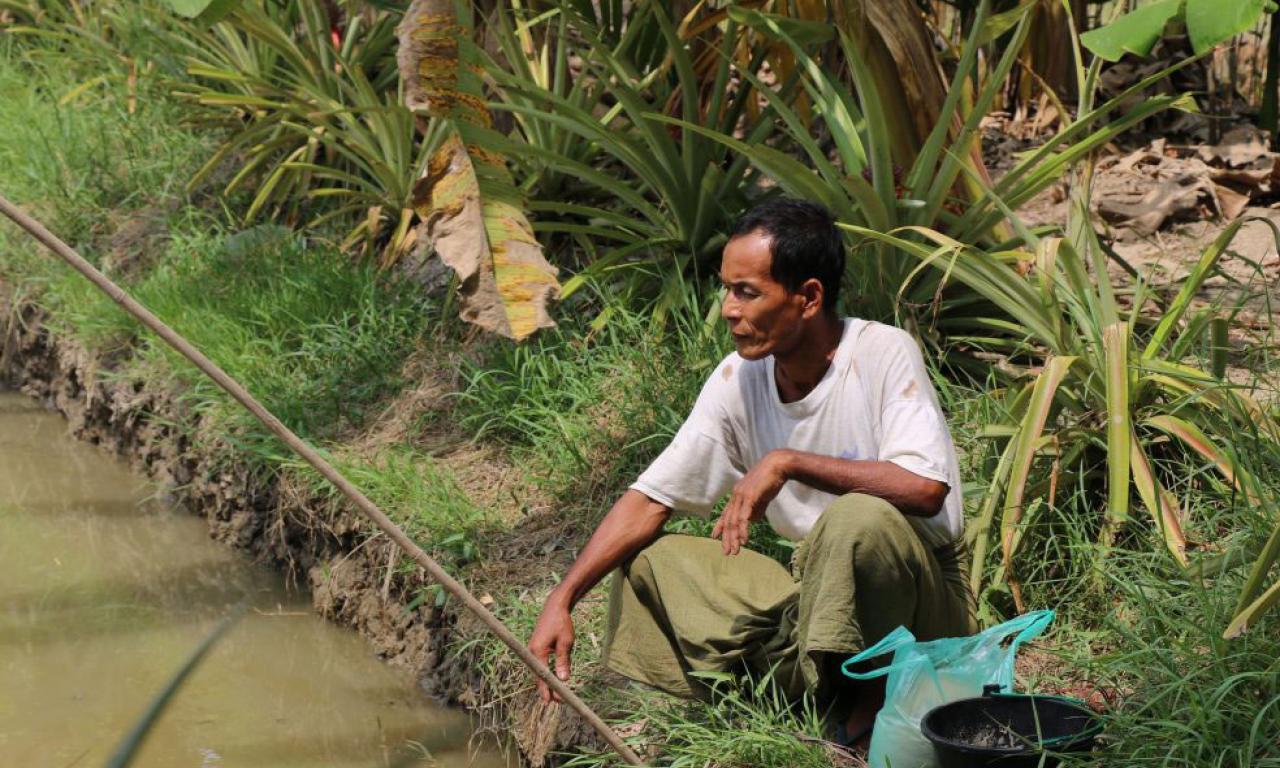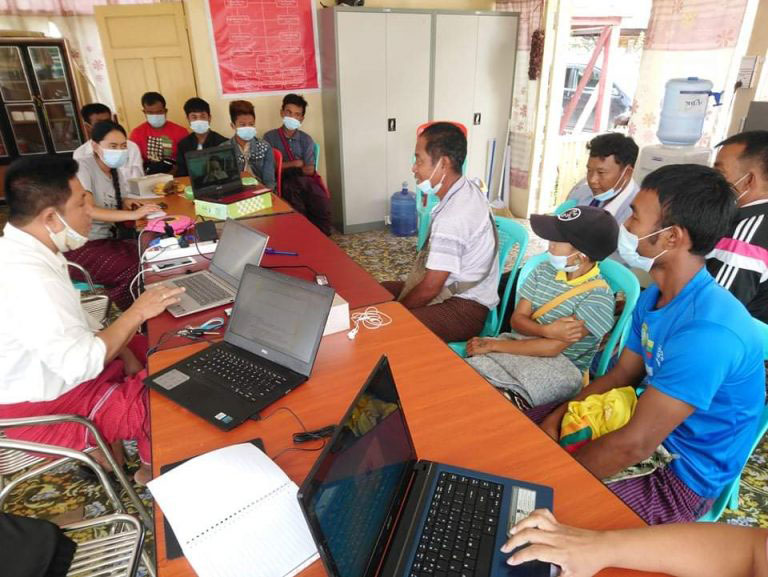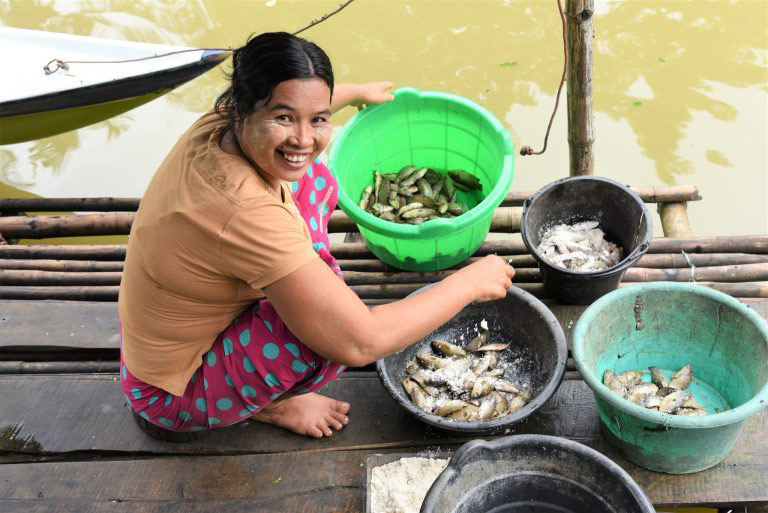
WorldFish researchers are working alongside small-scale aquatic food producers and value chain actors in Myanmar to strengthen the resilience of aquatic food-based livelihoods impacted by both COVID-19 and widespread pollution.
WorldFish researchers are working alongside small-scale aquatic food producers and value chain actors in Myanmar to strengthen the resilience of aquatic food-based livelihoods impacted by both COVID-19 and widespread pollution.
Aquatic foods caught and harvested in inland waters like lakes and rivers are a vital source of income and nutrition for many of Myanmar’s rural communities. Small fish are often the most accessible animal-source food and provide the micronutrients necessary for cognitive and physical development in children. The country’s fisheries and aquaculture sectors also provide employment to around 3.2 million people.
WorldFish is working to boost aquatic food systems and capture more economic, social, and ecological benefits from Myanmar’s fish production sector. However, environmental degradation and the COVID-19 health and economic crises are now compounding to stall both inland capture fisheries and the country’s emerging aquaculture sector.
In a bid to strengthen value chain resilience, researchers conducted a set of focus groups to assess the needs of food systems actors in order to increase small-scale fish production, aquatic food consumption, and labor productivity.
As part of the USAID-funded Fish for Livelihoods project, researchers partnered with Inle Lake Management Authority and Pekon Lake Conservation Committee to identify ways to support fishers, aquaculture farmers, and value chain actors through capacity development activities and additional training.
“The focus group discussions help build a bridge between fisherfolk and the research team. The results will be used to design future interventions that both increase stakeholder income and conserve freshwater resources,” said Dr. Manjurul Karim, Chief of Party for the Fish for Livelihoods project.
Focus groups illuminate environmental concerns

While demand for fish in Myanmar is growing, fish stocks are increasingly threatened by sewage overflows, agricultural runoff, unsustainable tourism, overexploitation, and a changing climate. These factors are compounding to threaten value chain actors dependent on robust and resilient inland waters.
“The livelihoods of fisherfolks who are living in and around Inle and Pekon Lake are in jeopardy due to the degradation of the lakes’ ecosystems,” said Kyaw Moe Oo, the field coordinator of Fish for Livelihoods.
Inside Inle Lake, floating gardens have crowded and narrowed the waterways; the lake is largely restricted to canals between gardens and farm plots. The expansion of artificial surfaces, combined with lower-than-average rainfall in recent years, has reduced Inle Lake’s area by more than a third.
Multiple pollution sources are also responsible for declining water quality in Inle Lake – untreated sewage from the watershed’s 160,000 residents, coupled with pesticide and fertilizer runoff, lead to changes in nitrogen and phosphorous levels and decrease the dissolved oxygen content, which can result in massive algae blooms that suffocate fish stocks.
Local fishers and fish farmers were aware of the threats to freshwater lakes and commented on fish mortality in focus group discussions.
“Fish died not only from the pesticides but also from the chemical inputs and rubbish from the many hotels. Moreover, the growing population is a problem,” said a focus group participant from the village of Nyuang Win.
As the population expands, infrastructure development and fishing pressure increase. Myanmar’s lakes are best known for traditional fishing practices, but there was a reported surge in electrofishing – a fishing method that employs an electric current to attract and temporarily immobilize fish for capture. Focus group participants expressed concern about the long-term sustainability of such fishing methods, which disproportionately kill-off juvenile fish before they have a chance to breed.
“It is good if the lake committee can control electrofishing long-term. If so, we can catch fish in the future. If they cannot control electrofishing, it will be difficult to find the fish and our families will suffer,” said a fisher from Pekon Lake.
Boosting the resilience of value chain actors

The impact of COVID-19 was sorely felt in communities dependent on fish for income and restricted their access to urban markets. With limited options, fishers and fish farmers around Inle and Pekon Lake became reliant on informal local brokers to provide loans with high interest rates.
The focus group enumerators found that in September 2020, only 10 percent of aquatic food producers were able to sell their products in formal markets due to travel restrictions. Most opted to sell their fish to traders at rates significantly below market value.
Isolated from trading opportunities, cash flow ceased in many rural communities. Moreover, fishers and fish farmers had minimal access to capital in the form of microcredit, group loans, or revolving funds. WorldFish’s Fish for Livelihoods project identified new investment opportunities via revolving loans funds as a means for development organizations to temporarily support value chain actors deprived of their income.
The limited knowledge of fishers on contemporary fishing practices, novel technologies, and value chains was another underlying issue for focus group participants. They expressed interest in enhancing their involvement in aquaculture production to increase their resilience in times of crisis.
“We would like to get the technology to establish fish hatcheries. We use the traditional ways when we breed the fish, but we need technology for commercial fish farming,” added a participant from Nyuang Win village.
Through the Fish for Livelihoods project, future interventions are planned to coordinate stakeholders and fill the identified gaps in aquaculture value chains and environmental protections. The present condition of the country’s inland waters, compounded with the pandemic, lead to novel opportunities to develop innovative solutions and implement community-based actions.
“By examining the key issues and challenges fisherfolk are facing, this study allows researchers to develop intervention strategies that enhance the capacity of fisherfolks, uphold environmental sustainability, and preserve the country’s rich aquatic resources for future generations,” said Kyaw Moe Oo.
